Bioactive Reptile Enclosure Setup: Step-by-Step Guide
Setting up a bioactive reptile enclosure is like creating a mini ecosystem! Start with the right size enclosure—nobody likes a cramped space, right? Then, choose a suitable substrate like coconut fiber or organic soil to keep it cozy. Add some live plants for a splash of green and hiding spots; your pets will thank you! Don’t forget heating and lighting for their happiness; it’s basically their version of a sunny vacation. If you stick around, I’ll share tips on cleanup crew organisms too!
Quick Takeaways
- Choose an appropriately sized enclosure that mimics natural habitats with land and water zones for your reptile’s needs.
- Select the right substrates, like coconut fiber or organic soil, to foster a healthy ecosystem and promote burrowing behavior.
- Incorporate compatible live plants and foliage to enhance aesthetics, provide hiding spots, and assist with moisture control in the enclosure.
- Install proper heating and lighting, including basking bulbs and full-spectrum LEDs, to maintain ideal temperature and UVB exposure for reptile health.
- Introduce a cleanup crew, including springtails and isopods, to break down waste and maintain a balanced and thriving environment.
Selecting the Right Enclosure Size and Type
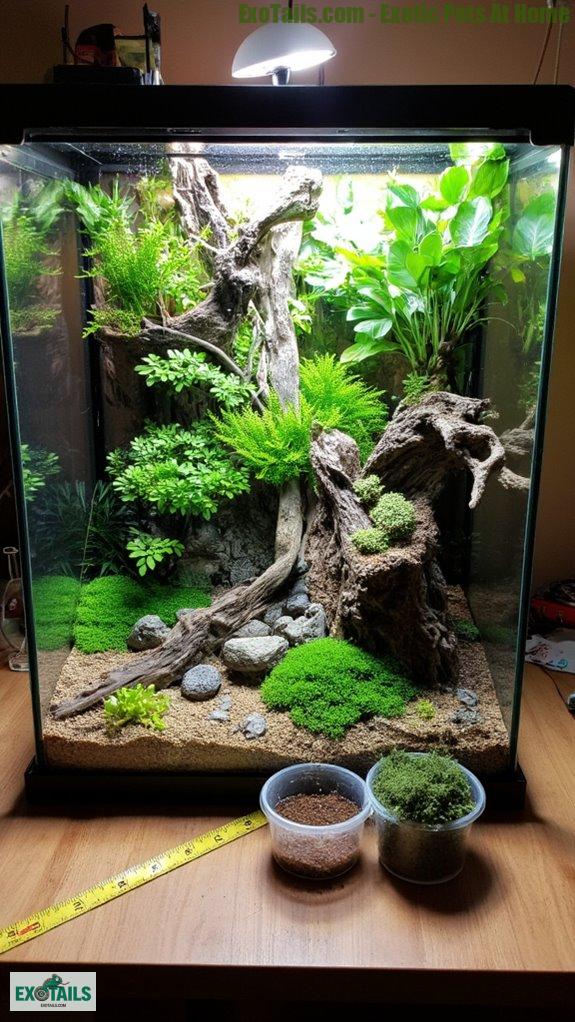
When it comes to creating the perfect home for your scaly friend, the size and type of enclosure can make all the difference—seriously!
Choosing the right enclosure dimensions isn’t just about looking good; it’s about habitat compatibility, too.
Selecting the ideal enclosure size isn’t just for aesthetics; it’s essential for your pet’s happiness and habitat compatibility!
Do you want your pet to feel cramped or like they’re in a cozy mansion? I prefer the latter, obviously!
Imagine customizing a space where they can thrive and explore.
Trust me, giving them room to roam reduces stress and boosts happiness. Additionally, a well-designed enclosure with land and water zones provides essential habitats that mimic their natural environment.
Choosing Suitable Substrate for Bioactivity
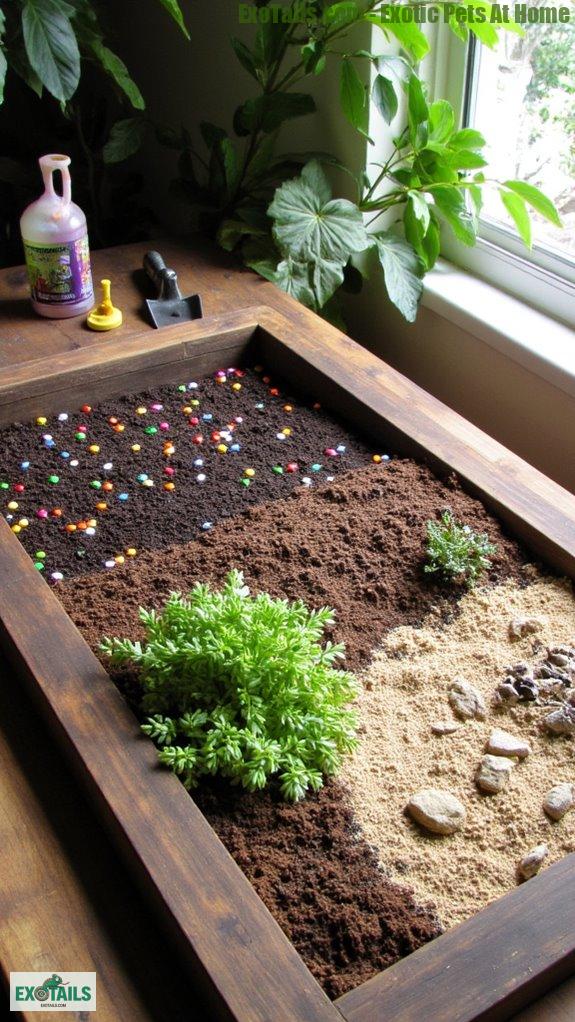
Creating a vibrant environment for your reptile isn’t just about choosing a stylish enclosure; it’s also about getting the substrate just right.
I’ve learned that selecting the right substrate types and ensuring the proper substrate depth is essential for bioactivity. It’s like setting up a cozy apartment for your cold-blooded buddy.
Here’s a quick overview:
| Substrate Type | Benefits | Ideal Depth |
|---|---|---|
| Coconut Fiber | Retains moisture, good for burrowing | 2-4 inches |
| Organic Soil | Nutrient-rich, great for plants | 4-6 inches |
| Sand | Encourages natural digging behavior | 3-5 inches |
Additionally, it’s important to incorporate beneficial bacteria into your substrate mix to promote a healthy ecosystem within the enclosure.
Incorporating Live Plants and Foliage
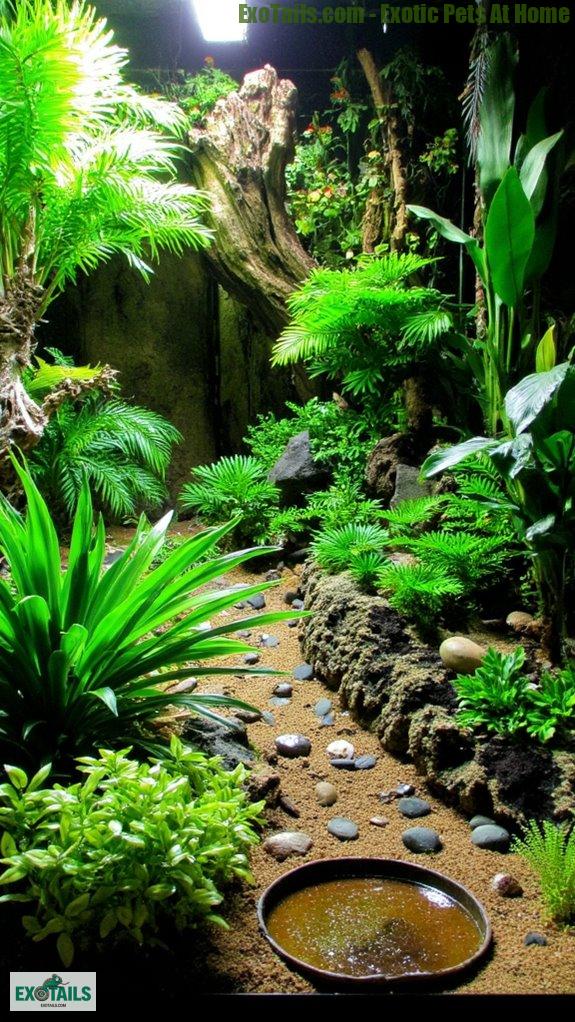
Incorporating live plants and foliage into your reptile enclosure not only beautifies the space but also creates a more natural habitat for your scaly friend.
I’ve found that choosing plants with good plant compatibility makes a world of difference.
By layering foliage, you can create hiding spots that mimic natural environments, which is key for reducing stress in your reptile.
Ever think about how amazing it is to add life to a space? Trust me, your setup will look so inviting!
Plus, it’s great for moisture control, so it’s like you’re a pro decorator and a reptile whisperer at the same time!
Additionally, ensuring that your plants receive adequate UVB lighting is crucial for their growth and overall health in the enclosure.
Installing Proper Heating and Lighting
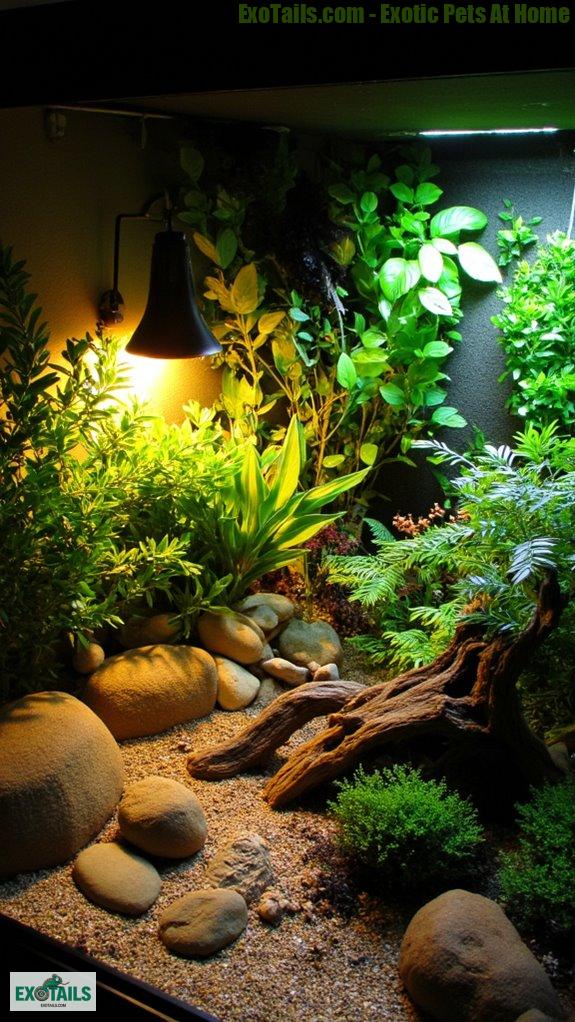
To guarantee your reptile thrives, you’ve got to prioritize proper heating and lighting as a crucial part of the enclosure setup.
Essentially, you want to create a hassle-free environment using reliable heat sources and the right light spectrum. I mean, who doesn’t love a cozy home?
Consider these points:
- Basking bulbs for essential warmth and UVB access.
- Ceramic heat emitters to maintain that perfect temperature without light.
- Full-spectrum LEDs to mimic natural daylight and keep the energy vibrant.
With the right setup, you’ll keep your pet happy—and trust me, a happy reptile means a happy you!
Adding Essential Decor and Hiding Spots
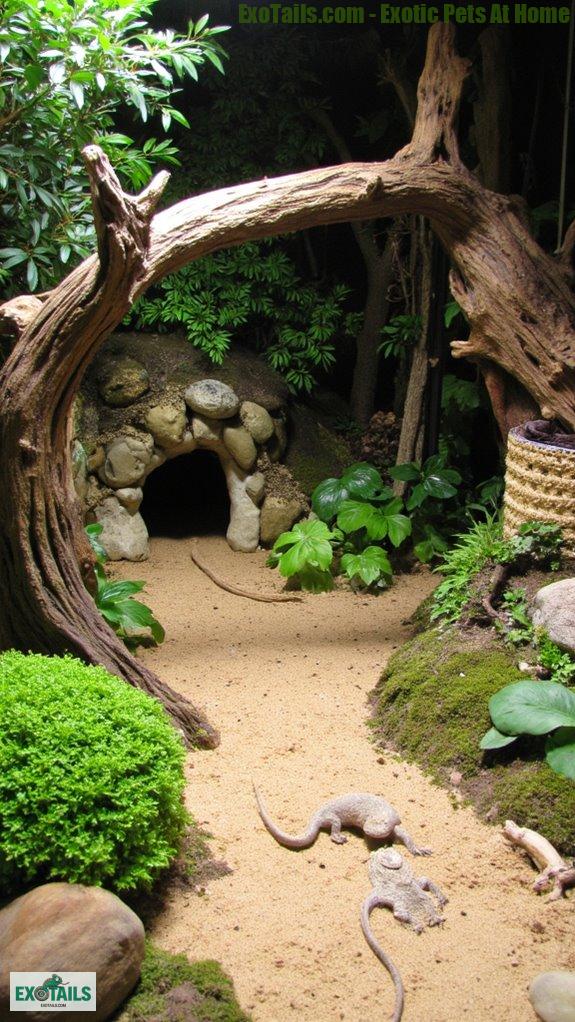
No reptile enclosure feels complete without some essential decor and hiding spots, right? I mean, even reptiles need their cozy corners!
Using natural materials like driftwood and moss creates a lively atmosphere and provides those much-needed hiding spaces.
Don’t forget about texture variety – it adds richness! Think climbing structures and decorative elements that invite exploration.
Shelter options, like caves or leafy groves, enhance comfort while serving as visual barriers.
Add in some playful enrichment items, and you’ve got a vibrant home that keeps them happy and healthy.
Trust me, I learned through my exotic pets and created ExoTails for you!
Introducing Cleanup Crew Organisms
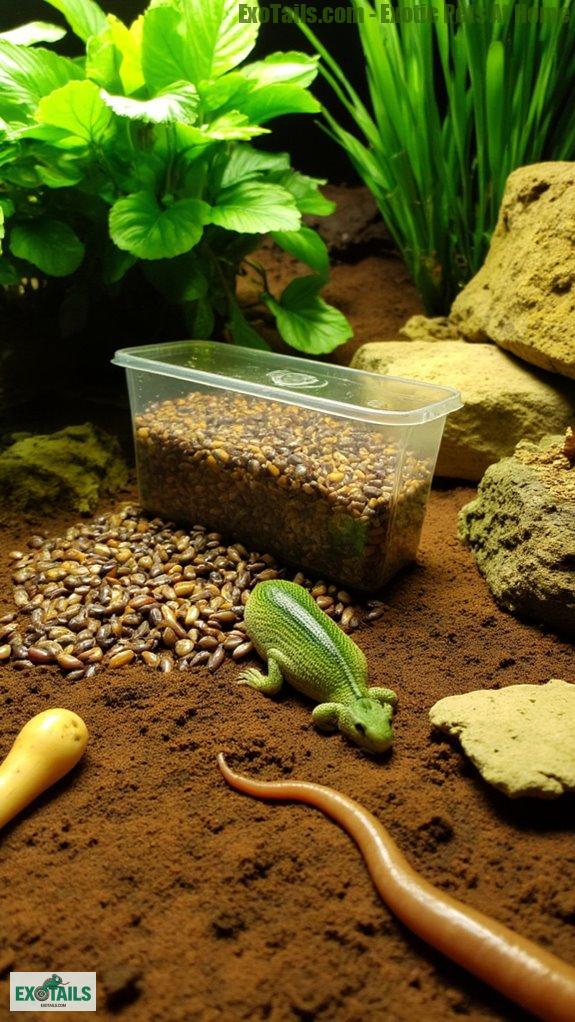
Every great reptile habitat deserves a trusty cleanup crew to keep things spick and span!
I can’t stress enough how essential they’re in maintaining a healthy ecosystem. These tiny heroes help manage organic waste, ensuring species diversity and population balance.
Consider adding these critters to your tank:
- Springtails: They feast on decaying matter, breaking it down into nutrients.
- Isopods: Known as pill bugs, they’ll munch on leftover food and help control mold.
- Earthworms: These soil engineers recycle nutrients while improving substrate health.
Trust me, your reptiles will thank you for this tidy little team!
Monitoring and Maintaining the Bioactive Environment
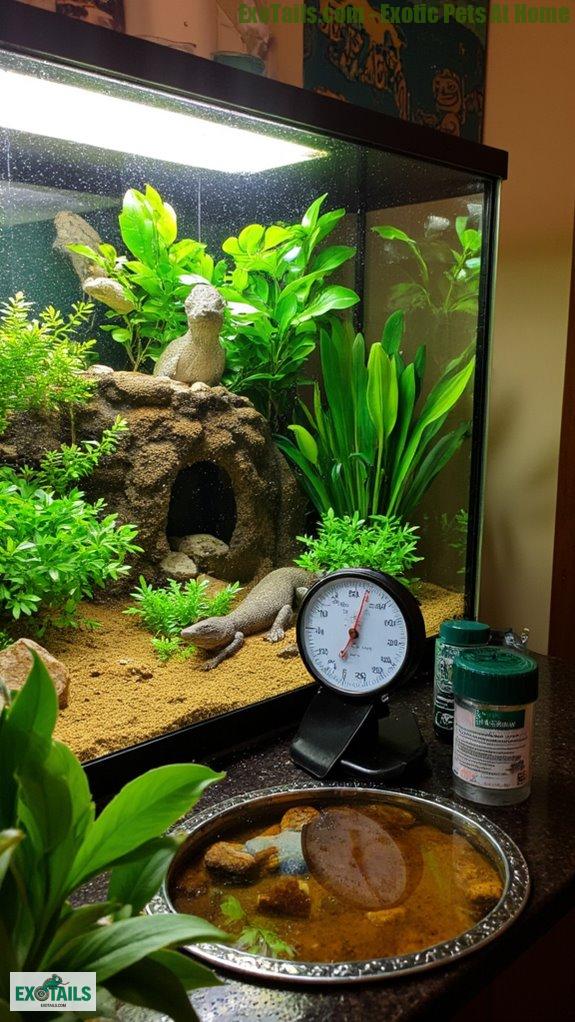
Keeping an eye on the health of your bioactive environment is like having a backstage pass to a lively concert—you don’t want to miss any of the action!
To maintain that vibrant ecosystem balance, I focus on humidity monitoring and temperature regulation. I use reliable tools to guarantee my substrate moisture remains just right, which keeps pests at bay and supports plant health.
Prioritizing water quality is vital; I make periodic checks to spot any issues.
Keep in mind, every creature interacts, so fostering those biotic interactions is key!
It’s a wild ride, but once you get it right, your enclosure thrives—just like my home decor!
Create Optimal Lighting Setup
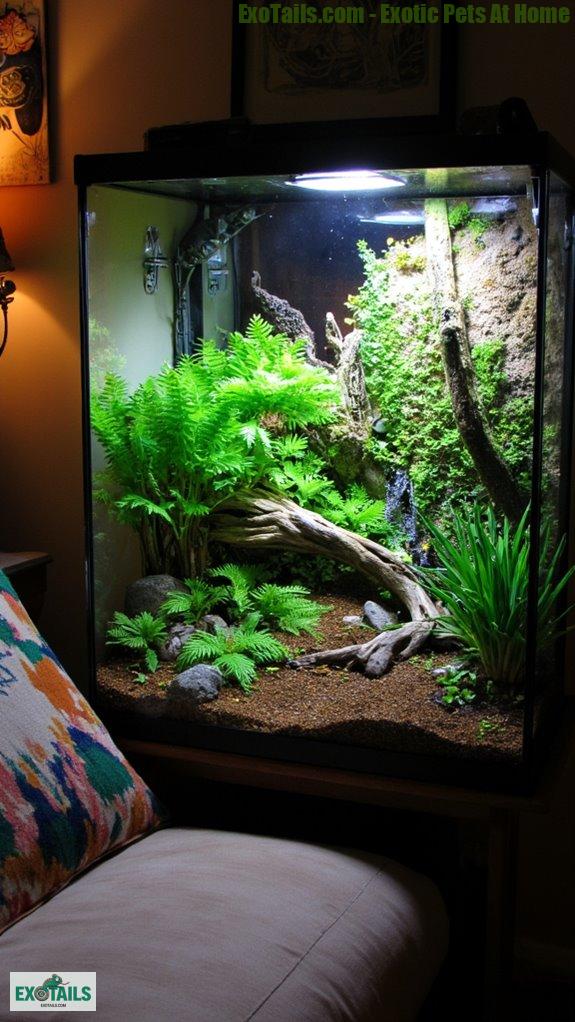
When it comes to creating the ideal lighting setup for your bioactive reptile enclosure, you’d be surprised at how much impact proper lighting can have.
The right light spectrum and heat sources are vital. Trust me, your little scaly buddy will thank you!
Choosing the perfect light spectrum and heat sources is essential for your reptile’s health and happiness!
Consider these essential lighting elements:
- UVB bulbs: They’re like sunshine in a box, promoting healthy calcium absorption.
- Heat lamps: These create cozy basking spots, just like a warm hug on a chilly day.
- LED lights: Energy-efficient and customizable for a perfect ambient glow.
With a little thought, you’ll balance beauty and function perfectly in your reptile paradise!
Questions and Answers
How Do I Choose the Right Reptiles for a Bioactive Enclosure?
Choosing the right reptiles for a bioactive enclosure involves evaluating their compatibility and substrate preferences. I make certain they thrive together, considering factors like size, temperament, and habitat needs, so I maintain control over the ecosystem’s balance.
Can I Use Artificial Plants in a Bioactive Setup?
Sure, I could fill my entire enclosure with artificial plants! They offer benefits like low maintenance while enhancing natural aesthetics. But recall, nothing beats the lively interaction from real plants that keeps me in control of the environment.
What Are Common Pests to Watch for in a Bioactive Environment?
In my experience, common pests in bioactive environments include mites and fungus gnats. I recommend using natural predators like nematodes for pest control, which keeps the ecosystem balanced and minimizes disruptions in the habitat.
How Often Should I Change the Substrate in My Enclosure?
I change my substrate every six to twelve months, depending on the types I’m using. Different substrate benefits—like drainage and humidity control—determine the frequency. Keeping it fresh guarantees a healthy environment for my reptiles.
Is It Necessary to Use a Drainage Layer in Bioactive Setups?
I believe using a drainage layer is essential. It promotes healthy water management, prevents root rot, and enhances bioactive system maintenance. You’ll find the added control makes your enclosure thrive and reduces potential issues.







